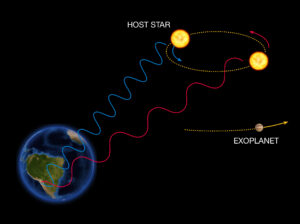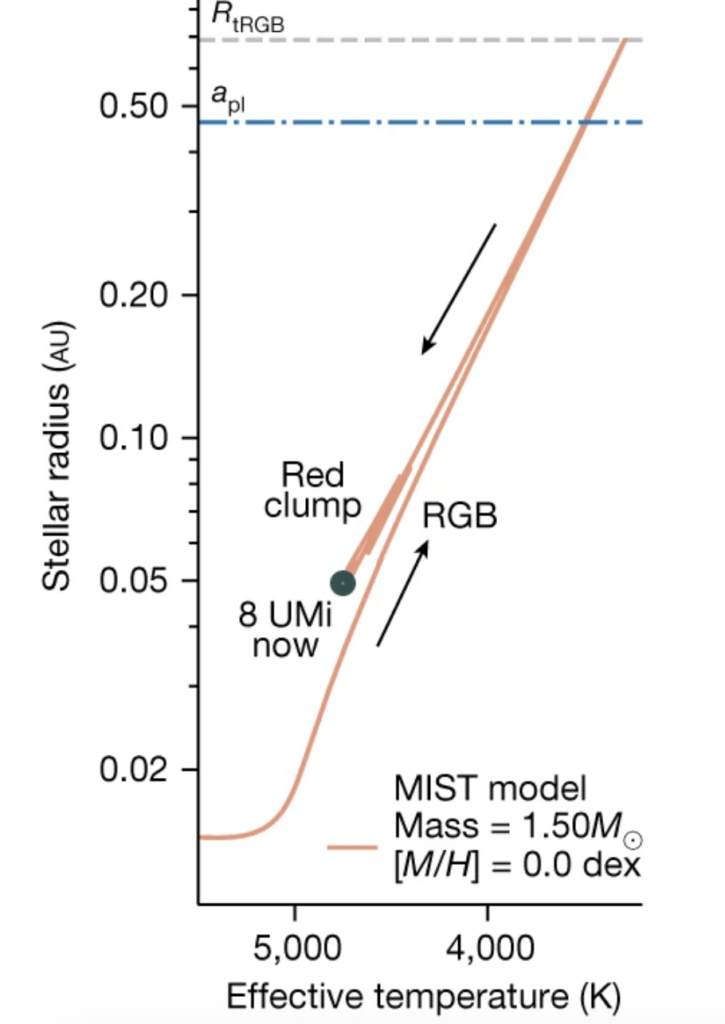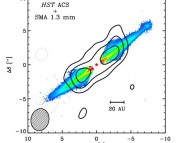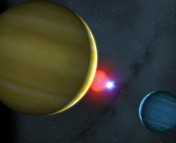Title: A Close-In Giant Planet Escapes Engulfment By Its Star
Authors: Marc Hon, Daniel Huber, Nicholas Z. Rui, et al.
First Author’s Institution: MIT Kavli Institute for Astrophysics and Space Research, Cambridge, MA, USA
Status: Accepted to Nature [closed access]
Planets outside our solar system, or exoplanets, were things of science fiction until the 90s, when the first exoplanet was discovered. In the ~30 years since, the field of exoplanets has exploded, and astronomers have now confirmed over 5,000 of them! The Universe is teeming with exoplanets, yet we know very little about what happens to these planets as their host stars evolve. While most planets have been found around young stars, like our Sun, we can gain insight on the fate of planets by looking for them around old stars. We now know of a couple these systems, such as WD 1856+534, the first transiting planet around a white dwarf. The authors of today’s paper present a detection of a planet orbiting around its middle-aged host star – a star that was predicted to eat any planets in its way. Now the question remains, how does this planet exist?
Planet Detection

(Image Credit: Wikipedia)
The giant planet 8 Ursae Minoris b, cutely nicknamed 8 UMi b, was discovered to orbit its host star with a period of 93 days. It was initially observed with the Bohyunsan Observatory Echelle Spectrograph (BOES) at the Bohyunsan Optical Astronomy Observatory (BOAO) in South Korea, and later followed up by the authors with the High-Resolution Échelle Spectrometer (HIRES) on the Keck-I telescope at Maunakea, Hawaii. These two instruments search for close-in planets by using the radial velocity technique, a common method that relies on observing a star for signs of movement induced by an orbiting planet (see Figure 1).
Using this technique, the authors were able to detect this planet and constrain its mass, confirming that 8 UMi b is a giant planet with a mass of ~1.65 times the mass of Jupiter. Thousands of Jupiter-like planets have been detected to date, but what makes this planet particularly interesting is its host star.
Stellar Evolution

Stars expand as they age off of the main sequence, becoming “Giant” stars. Gianthood can be a violent part of stellar evolution consisting of several phases (including the RGB, HB, and AGB phases), in which the dying star will expand and contract several times before it dies. These phases correspond to the elements burning in the core and the surrounding shells of gas at a given time. In order to determine the specific phase of evolution the star 8 UMi currently occupies, the authors use a technique known as asteroseismology.
Similar to using seismology to study earthquakes, astronomers can use asteroseismology to study “star-quakes”, or stellar oscillations driven by turbulence or gravity. Asteroseismology informs us about the internal composition of stars by studying the way waves propagate from the core to the surface. With this technique, the authors determined that 8 UMi is a core-helium-burning giant. In the context of stellar evolution, this star has evolved past the first phase in giant evolution (the Red Giant Branch, or RGB), where it runs out of hydrogen in its core and swells to a radius that can completely engulf any inner planets. Now, it is in the next stage, known as the Horizontal Branch (HB) where the ignition of helium in the core causes the star to shrink in size. This makes 8 UMi b the first planet detected around a Horizontal Branch star (in particular, 8 Umi occupies the red clump, a clustering of Horizontal Branch stars on the Hertzsprung–Russell diagram at around 5,000 K) . Figure 2 provides an evolutionary model for 8 UMi, demonstrating that its radius once exceeded the semi-major axis of 8 UMi b. If 8 UMi b maintained its current semi-major axis throughout its lifespan, it should have been entirely consumed by its host star!
How does 8 UMi b exist?

Although low-mass stars or brown dwarfs may survive host-star engulfment, the authors state that this was likely not the case for 8 UMi b. In order for a secondary body to survive engulfment, it must be energetic enough to fully eject the envelope of the primary star. The amount of energy a secondary body is able to release depends on its mass and its orbital separation. In the case of 8 UMi b, the authors demonstrate that the observed semi-major axis of 8 UMi b is too close to have enough energy to eject any of the envelope, regardless of its mass.
Instead of evolving as a single star, the authors suggest that 8 UMi may have once been a part of a close binary system. In this scenario, the primary star evolves into a white dwarf, then merges with the secondary star, resulting in a single star that is massive enough to initiate core-helium-burning without ever growing to a radius beyond the semi-major axis of 8 UMi b (see Figure 3). This hypothesis is bolstered by the large abundance of lithium detected in 8 UMi b, which is often associated with white dwarf–red giant mergers.
While 8 UMi b may not be a death-defying planet, its existence is a testament to the importance of searching for planets around aging stars. Finding more systems like this will help astronomers solve the puzzle of what happens to planets as their host stars age, and the ultimate fate of our own.
Astrobite edited by Sahil Hegde and Catherine Slaughter
Featured image credit: W. M. Keck Observatory/Adam Makarenko




